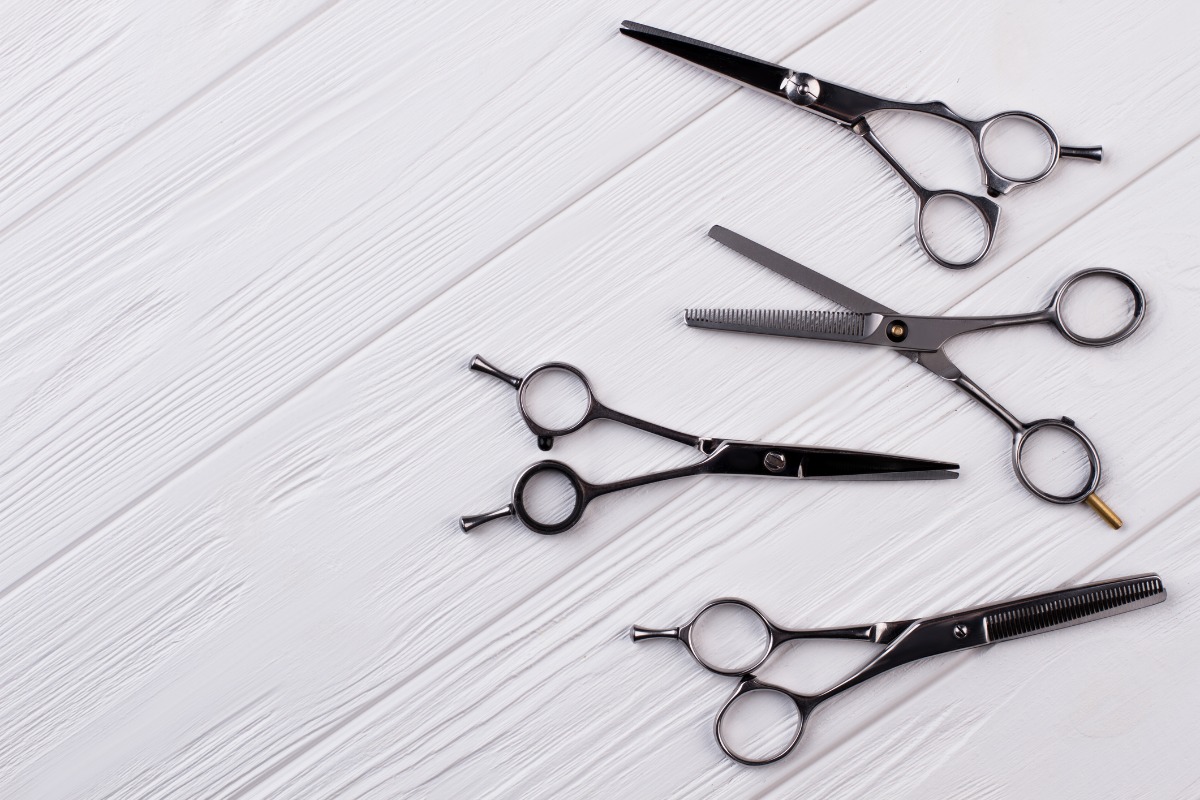The most popular kind of scissors blade is the single bevel blade. Its popularity is also why it is known as the standard blade. It is a lightweight, flat blade that gives a very smooth cut.
The most popular salon scissors use sharp convex or bevel blade edges for Australian hair professionals.
Hair Scissors Blade Types and Shapes

Choosing the right hair scissors blade type can make all the difference between a good haircut and a bad one. It can make the difference between a good barber and a poor one.
The edge type and material determine the type of cut it is best for.
The various types of hair scissors blade include the convex blade, bevelled blade, serrated blade, and sword blade.
The Flat Blade or Standard Blade
The standard blade is a flat blade that is the most common and inexpensive blade available worldwide.
It is a light blade with a 45⁰ angle. It has a flat face that fits both the comb face and the hair.
It is also an efficient blade that works well for smooth cuts.
But this blade can’t be used for elaborate hair cutting techniques like slide cutting. It’s mostly suited for simple cuts. The blade is designed for more application of pressure and force.
Scissor Blade Width
The width of the blades depends on the type of blade, and its purpose. Wider blades are used for powerful blades. Thinner blades are for light cutting and more detailed cutting.
Heavy point cutting and blunt work are best done using narrow-bladed scissors that are slim and long. These blades often have a radius that ranges from 900mm to 1000mm. They also have an angle of 50⁰ to 55⁰.
Scissor Blade Lines
Scissor blade lines range from curved blade lines to straight blade lines. Straighter blades are simply known as a straight blade. The ordinary blade is known as the willow blade.
The larger the curve, the more the hair that will slide when you are cutting the hair for a soft, smooth cut. The blade with the biggest curve is the bamboo leaf blade which is also used for slicing and slide cuts.
The Convex Scissor Blades
Convex scissor blades include the convex shape blade and the convex pro blade.
Convex Pro Blade
The convex pro blade is for those that want to give the sharpest cuts. It is designed for intricate, complicated cuts. The blade was finished manually by craftsmen to give it the detailed, artistic feel that it needs.
It has a powerful cross-section with a point that is smaller than a hair so that the hairs won’t fly around. It also has a curved outer surface that combines with other parts of the blade for slide cutting and other advanced cutting techniques. It produces powerful, sharp, smooth cuts.
It is an expensive blade that is more difficult to produce than others.
Convex Shape Scissor Blade
The convex shape blade is an improvement over the regular blades. It is a vast technological improvement over the status quo. It is sharp, soft, and can be used by anyone.
It is best used for point cutting, texturizing, and slide cutting. It comes with a thin, flat, hone line on the hollow edge that runs from the scissors tip to the back. The hone line is necessary to avoid the rubbing together of the edges that occur because of their sharpness.
The Sword Shape Blade
The sword shape blade is shaped like a sword. It comes with a sword blade and a convex edge or clam shell. It delivers power at the point of the blade. The sword shape blade provides power to the blade for precision, accuracy, and quality cuts.
It comes with a ridge that runs through the length of the blade to achieve powerful cuts that are independent of the blade length.
This is a far cry from other scissor blades whose power depends on the length of the scissors. The scissor blades work for cutting just as expected.
The Concave Scissors Blade
The concave scissors blade comes with a keen edge for sharp cutting. It cuts hair with minimal effort as its cutting load is lower than that of existing scissors.
Serrated and Micro-serrated Blades
Micro-serrated blades have fine grooves on the cutting edges of the scissors. The serrated edge comes with micro-serrations from the tip to the end.
Serrated blades work well for cutting coarse hair. The edge catches hair and stops pushing, making it perfect for slow detail cutting, dry cutting, and wigs. It is also beginner-friendly and inexpensive. In addition, they are good for scissor over comb cutting.
Micro-serrated blades also have the advantage of reducing blade fatigue once the cutting edge becomes dull due to constant usage. Also, if scissors with micro-serrated edges bump into a hard surface and the edge bumps into something, the serrated edge will prevent it from taking too much damage.
A major disadvantage of them is that they can’t be used for slice cutting as the hair will get stuck on the blade. Also, the cuticles could get damaged as the serrated blade cuts through the hair as it holds the hair like a comb.